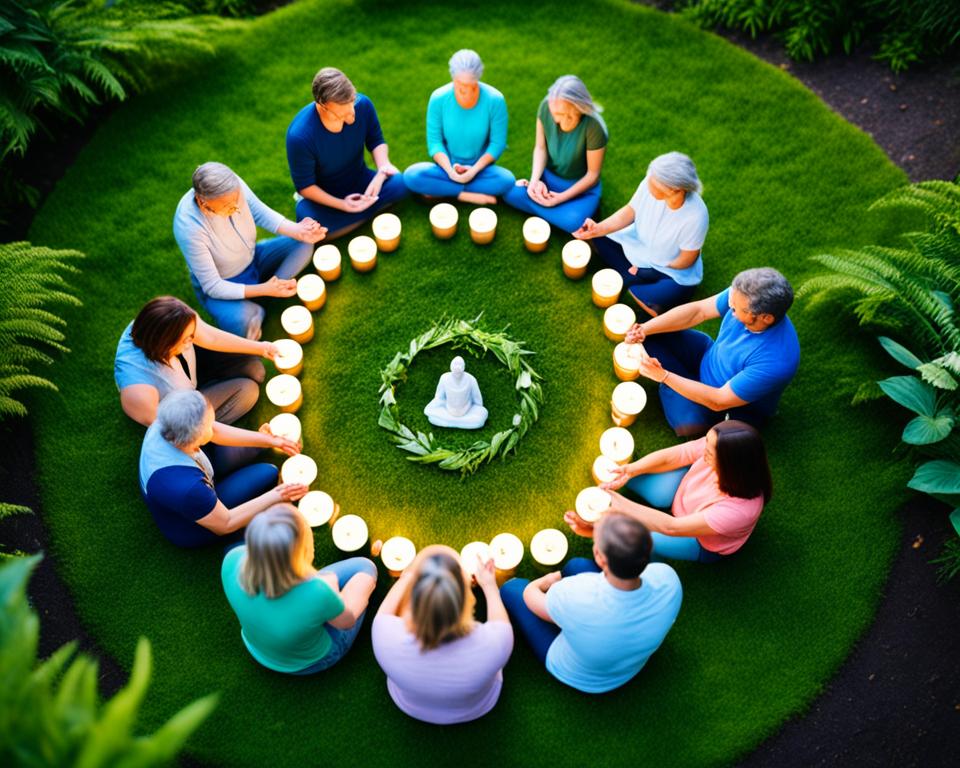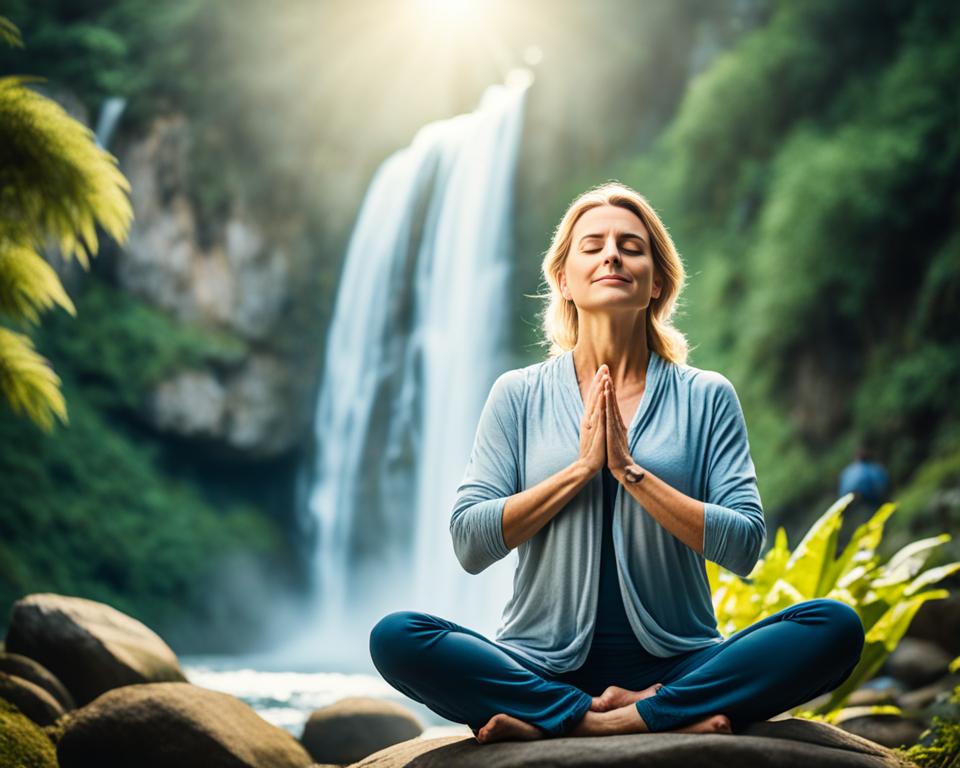Start your journey to better health and well-being with meditation. This guide will teach you the basics of mindfulness and stress relief. It’s perfect for beginners or those wanting to improve their practice.
You’ll learn how to connect your mind and body through meditation. We’ll cover different meditation styles and how to overcome obstacles. Discover guided meditations, apps, and communities to support your practice.
Get ready to see how meditation can change your life. It can improve your physical, mental, and emotional health.
Read more interesting information at ::infosavjetnik
Understanding the Power of Meditation
Meditation is a powerful practice that can change your life. It helps with your physical, mental, and emotional health. By connecting your mind and body, you can enjoy many benefits.
Exploring the Mind-Body Connection
Meditation shows us that our thoughts, feelings, and body sensations are linked. When we quiet our minds, we find harmony between our mental and physical states. This connection is key to meditation’s powerful effects.
Unlocking the Benefits of Mindfulness
Regular meditation helps you become mindful. This means being fully present and aware of your thoughts, feelings, and body. Being mindful can reduce stress and anxiety, improve sleep, and boost focus and concentration. It can even make your immune system stronger.
| Meditation Technique | Mindfulness Exercise | Meditation Benefit |
|---|---|---|
| Breath Awareness | Body Scan | Stress Reduction |
| Mantra Meditation | Loving-Kindness | Improved Emotional Well-Being |
| Guided Visualization | Mindful Walking | Enhanced Focus and Concentration |
Anyone can benefit from meditation and mindfulness. Adding these practices to your life can greatly improve your health and happiness. By understanding meditation’s power, you can start a journey of self-discovery and growth.
“Meditation is not about becoming a different person, but about creating who you are.” – Deepak Chopra
Setting the Stage for Meditation
Before starting your meditation journey, make sure you have the right setup. This includes creating a peaceful space and sticking to a regular routine. Doing so can greatly enhance your ability to relax deeply and stay mindful.
Finding the Right Time and Place
For beginners, picking the perfect time and spot for meditation is key. Look for a quiet spot where you can sit comfortably without being disturbed. Many find mornings or evenings work well since they are usually calmer.
Think about the lighting, temperature, and noise when choosing your space. Aim for a spot that feels calming and welcoming, whether it’s a special room or a quiet corner at home.
Building a Sustainable Routine
Being consistent is vital for creating a meditation routine. Try to set aside a specific time daily, even if it’s just a few minutes. This tells your brain and body that meditation is a regular part of your day.
- Start small and gradually increase the duration of your sessions.
- Choose a time that fits your schedule, like before work, during lunch, or before bed.
- Try different times to find what feels most natural and doable for you.
By preparing your space and sticking to a routine, you’re setting yourself up for the many benefits of meditation.
How to Meditate for Health and Healing
Step-by-Step Guide to Mindful Meditation
Starting your meditation journey can greatly improve your health and wellness. This guide will show you how to meditate mindfully. You’ll learn to relax deeply and stay present.
- Find a quiet spot to sit comfortably, either on the floor or in a chair with support.
- Focus on your breath. Take slow, deep breaths, feeling the air move in and out.
- Pay attention to now. Notice your body, the sounds, and any thoughts or feelings without judging them.
- If your mind wanders, bring your focus back to your breath. It’s normal.
- Start with 5-10 minutes of mindful breathing and body awareness. Increase the time as you get better at it.
Being consistent is key to seeing the benefits of meditation. Make these exercises a part of your daily life. You’ll notice a calmer mind, less stress, and better overall health.
| Meditation Technique | Benefits |
|---|---|
| Mindful Breathing | Reduces stress and anxiety, improves focus and concentration |
| Body Scan | Enhances body awareness, promotes relaxation and healing |
| Mantra Repetition | Calms the mind, cultivates inner peace and clarity |
“The beauty of meditation is that it’s accessible to everyone, no matter your experience level. Start small and be patient with yourself. Over time, you’ll discover the profound power of these mindfulness exercises to transform your health and well-being.”
Breathing Techniques for Deeper Relaxation
Learning to breathe deeply can change your meditation techniques and mindfulness exercises for the better. By using special breathing methods, you can make your meditation more effective. This leads to more stress relief through meditation and a deeper sense of calm.
Diaphragmatic breathing, or “belly breathing,” is a key technique. It means breathing deeply so your belly moves in and out with each breath. This type of breathing calms your mind, lowers stress, and helps you focus better.
- Sit or lie down in a comfy spot, with your eyes closed or looking down softly.
- Put one hand on your belly and the other on your chest.
- Breathe in slowly through your nose, feeling your belly go up as you fill your lungs.
- Breathe out slowly through your mouth, letting your belly go back down as you release the air.
- Keep doing this, paying attention to how the breath moves in and out.
Meditation technique alternate nostril breathing is also powerful. It balances your mind and body. You breathe in through one nostril and out the other, then switch sides.
- Sit comfortably and use your thumb to block your right nostril.
- Breathe in slowly through your left nostril, then close it off with your index finger.
- Exhale through your right nostril, then breathe in through it.
- Close your right nostril and breathe out through your left nostril.
- Keep switching nostrils, doing this for a few minutes.
Adding these breathing techniques to your mindfulness exercises and meditation can make you more relaxed. It can also reduce stress and anxiety. Try different methods to see what works best for you.
Incorporating Meditation into Your Daily Routine
Adding how to meditate for health and healing to your daily life is key. It helps you build a lasting practice. A meditation routine that fits your schedule can bring big benefits.
Finding the Right Time and Place
Finding a special time and place for meditation is important. Think about your daily routine and pick the best times for you. This could be early morning, during lunch, or right before sleep. Make sure your chosen spot is quiet and comfy, with no distractions.
- Make a special spot in your home or office for meditation. Use it every time.
- Try different times to see what works best with your energy and schedule.
- Turn off notifications and set clear boundaries with others to avoid interruptions.
With some creativity and effort, you can make creating a meditation routine a normal part of your day. This supports your health and happiness.
Meditation for Stress Relief and Anxiety Management
In today’s fast-paced world, managing anxiety and stress is key. Meditation is a powerful way to find inner peace and emotional strength.
Calming the Mind and Body
Meditation helps you focus inward, quieting your thoughts and bringing you to the present. This can slow your heart rate, lower your blood pressure, and activate your “rest and digest” system.
By practicing meditation for stress relief and meditation for anxiety, you can better control your emotions. Mindfulness exercises make you more aware of your thoughts and feelings. This helps you stop worrying and thinking too much.
Through stress relief through meditation, you can handle stressful situations better. You’ll feel less overwhelmed and more peaceful. Studies show meditation is great for your mind and body.
“Meditation is not about becoming a different person, a new person, or even a better person. It is about training in awareness and learning to be present.”
– Jon Kabat-Zinn, Founder of Mindfulness-Based Stress Reduction (MBSR)
| Meditation Technique | Benefits for Stress and Anxiety |
|---|---|
| Breath Awareness | Promotes relaxation, reduces physiological arousal |
| Body Scan | Increases awareness of physical sensations, reduces muscle tension |
| Mantra Repetition | Calms the mind, redirects attention from worries |
| Loving-Kindness (Metta) | Fosters self-compassion and positive emotional states |
Exploring Different Meditation Styles
The world of meditation is vast and diverse, offering many techniques and approaches. Whether you want to improve focus, practice mindfulness exercises, or find yourself, there’s a meditation style for you.
Focused attention meditation is popular. You focus on something like your breath or a mantra. This helps you stay in the moment and feel calm and concentrated.
Open monitoring meditation is different. It’s about watching your thoughts and feelings without judgment. This style helps you accept everything that comes your way, making you more aware and compassionate.
Guided meditation is perfect for beginners. Experienced instructors lead these sessions, giving clear instructions. It makes starting meditation easier and helps you stick with it.
| Meditation Style | Key Characteristics | Benefits |
|---|---|---|
| Focused Attention | Directing your attention to a specific object or sensation | Enhances focus, reduces distractions, and promotes calm |
| Open Monitoring | Cultivating a non-judgmental awareness of thoughts, emotions, and sensations | Fosters acceptance, equanimity, and emotional regulation |
| Guided Meditation | Practicing meditation with the guidance of an instructor | Supports meditation for beginners and helps establish a consistent routine |
It’s important to try different meditation techniques and mindfulness exercises to find what works best for you. By exploring, you can discover the power of meditation and grow personally.
“Meditation is not about becoming a different person, but about creating who you are.” – Osho
Using Guided Meditations and Apps
Take your meditation to the next level with guided meditations and mobile apps. These tools are great friends on your path to better health, healing, and peace.
Enhancing Your Practice with Technology
Guided meditations come in audio or app formats. They offer a clear path for both new and seasoned meditators. Led by skilled teachers, these recordings help you focus, deepen your awareness, and relax deeply.
Meditation apps add more to your practice. They have timers, track progress, and offer many guided meditations and exercises. These apps make meditation easy, fun, and fit your needs.
- Explore a variety of guided meditations, ranging from stress relief to sleep enhancement
- Discover meditation apps that cater to your personal preferences and goals
- Leverage technology to make your practice more consistent and measurable
Guided meditations and apps are great for anyone, whether you’re just starting or deepening your practice. They can change your wellness routine for the better. Use technology to boost your mindfulness, lower stress, and increase your well-being.
Overcoming Common Challenges in Meditation
Meditation can change your life, but it’s not easy. Meditation for beginners and those trying to keep it up might face issues like feeling restless, getting distracted, or losing focus. But, you can beat these problems and grow strong and patient for a lasting meditation practice.
One big challenge is dealing with difficult emotions. When you sit quietly, hard thoughts and feelings might come up that you’ve been avoiding. Don’t try to ignore them. Instead, accept them with kindness.
“Meditation is not about getting rid of emotions, but about learning to relate to them with greater ease and understanding.”
Another issue is a wandering mind. It’s normal for your thoughts to wander during meditation. But, you can train to keep your focus. Use your breath or a simple mantra to keep your mind in the present.
- Try different meditation methods to see what suits you.
- Use mindfulness all day, not just during meditation.
- Be patient and kind to yourself – getting better takes time, and it’s okay to have ups and downs.
Accepting the good and bad of your meditation journey is key to maintaining a consistent meditation practice. By being resilient and kind to yourself, you can get past the usual hurdles and enjoy meditation’s deep rewards.

The Benefits of Meditation for Physical Health
Meditation is more than just a mind exercise; it’s great for our bodies too. It connects our mind and body, helping our immune system, healing processes, and preventing health issues.
Boosting Immunity and Healing
Studies show that meditation can boost our immune system. Meditation benefits like lowering inflammation and making more antibodies help our immune cells work better. This means we can fight off sickness faster and heal quicker.
By learning how to meditate for health and healing, we unlock our body’s healing powers. Meditation helps with wound healing, lessens pain, and controls chronic conditions like high blood pressure and diabetes. Boosting immunity through meditation keeps us healthy and strong.
| Meditation Benefit | How it Supports Physical Health |
|---|---|
| Reduced inflammation | Lowers the risk of chronic diseases and supports healing processes |
| Increased antibody production | Strengthens the immune system’s response to pathogens |
| Regulated immune cell activity | Enhances the body’s ability to fight off infections and diseases |
| Improved wound healing | Accelerates the body’s natural healing mechanisms |
| Reduced pain perception | Helps manage chronic pain and discomfort |
Adding meditation to your daily life can greatly improve your physical health. Discover the amazing benefits of meditation and how it helps your body heal naturally.
Meditation for Mental Clarity and Focus
Regular meditation can greatly improve mental clarity and focus. It helps create a calm, centered mind. This leads to a sharper, more focused mind that boosts productivity and decision-making skills.
Meditation makes it easier to concentrate and stay focused. This means you can work more efficiently and feel more accomplished in your work and personal life.
It also makes dealing with life’s challenges easier. By watching thoughts and feelings without judgment, you can solve problems and make decisions with a clear mind.
Unlocking the Cognitive Benefits of Meditation
Regular meditation offers many cognitive benefits:
- Enhanced mental clarity and focus
- Improved memory and recall
- Increased problem-solving and critical thinking skills
- Reduced mental fatigue and increased productivity
- Better emotional regulation and stress management
| Meditation Practice | Cognitive Benefits |
|---|---|
| Mindfulness Meditation | Improved attention, focus, and concentration |
| Mantra Meditation | Enhanced memory and cognitive flexibility |
| Loving-Kindness Meditation | Increased emotional intelligence and empathy |
“Meditation is not about becoming a different person, a new person, or even a better person. It’s about training in awareness and learning to be present.”
Adding meditation to your daily life can help you stay mentally clear and focused. It positively affects both your personal and professional life. Whether you prefer mindfulness or other meditation styles, the benefits are deep and can change your life.
Joining a Meditation Community or Retreat
Finding a meditation community or going to a retreat can change your life. These places let you deepen your practice, learn from experts, and feel like you belong with others who share your interests.
Deepening Your Practice with Support
Being part of a local meditation group or class helps you stay on track. You’ll get structured sessions, workshops, and group meditation chances. This lets you learn new ways to meditate and get advice from others.
For a deeper dive, think about a meditation retreat. These can last from a weekend to several weeks. They let you focus on meditation without daily life’s distractions. At a retreat, you’ll learn more about meditation, try different styles, and meet people who think like you.
| Benefits of Joining a Meditation Community or Retreat | What to Look for |
|---|---|
|
|
Choosing to join a local group or go to a retreat can greatly help your meditation journey. You’ll get support and guidance that can make a big difference in your practice and life.

“The journey of a thousand miles begins with a single step. Surround yourself with a community that will support you every step of the way.”
Conclusion
Meditation is a powerful way to improve your health and well-being. It helps you connect your mind and body deeply. This connection brings many benefits, like less stress and anxiety, better mental clarity, and faster physical healing.
By learning how to meditate for health and healing, you can start a journey of self-awareness and growth. Mindfulness exercises can lead you to a deeper understanding of yourself.
This guide has shown you the basics of meditation and how to use it in your daily life. It doesn’t matter if you’re new to meditation or have been doing it for years. The advice and tools here can help you enjoy the meditation benefits and live a more balanced life.
The journey of meditation is just as important as reaching a goal. Face challenges, celebrate your wins, and trust in meditation’s power. With effort and patience, you’ll see how how to meditate for health and healing changes your life. It will make you more mindful, centered, and purposeful.
